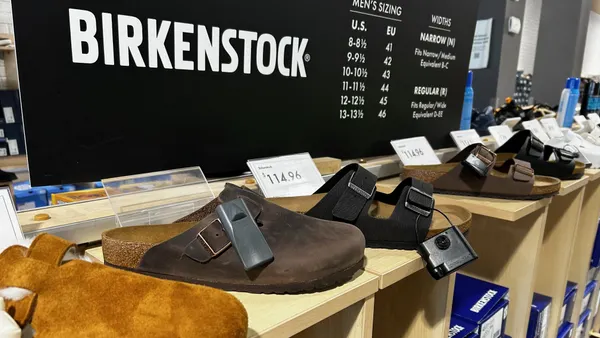As Irish fast-fashion retailer Primark establishes a physical presence in the U.S., its e-commerce presence is notably lacking.
Primark opened its first U.S. store in Boston in September, followed by a location in Philadelphia in November. The retailer plans to open at least seven more in the next two years.
Primark, owned by British conglomerate Associated British Foods, is one of the few major retailers left to only sell its goods in-store. The unique strategy may work for the company and certain other ultra-low price retailers, but it isn't a smart move for most stores, according to industry experts.
Another fashion retailer with a strategy of avoiding e-commerce is Ross Stores Inc., which owns Ross Dress for Less off-price department stores, said retail consultant Jan Rogers Kniffen. Even off-price competitor TJ Maxx now offers some items online.
"Everybody has sort of at least tipped their hat to it now, except for Primark and Ross," said Kniffen, CEO of J. Rogers Kniffen WWE. Here's why.
The case for in-store only
At Ross and Primark's price point, which is lower than fast-fashion retailers H&M or Forever 21, it's difficult to sell enough volume per online order to cover the cost of overhead and shipping, Kniffen noted. Customers aren’t likely to pay $10 to ship a $10 item, he said.
"So they looked at it and said, 'The way we win is price, and we’re going to win on price, and we will be compelling enough on price that we can hold our traffic volumes and do enough business that we can avoid playing the online game,'" he said. "That's the only reason that it may work for them."
Kniffen is a big fan of Primark and has spent time at both of its U.S. stores. He said the retailer already has proven it can run $800 per-square-foot stores internationally, and they expect to achieve more in the U.S.
"There’s a niche for everybody, depending on how you play the game," he said.
A different mentality
It's not that Primark only appeals to shoppers who wouldn't normally shop online in the first place. Kniffen surveyed shoppers at both locations and found that many who stopped at the Boston location tended to be millennials who also like to shop at H&M, Forever 21, and Marshalls. The Philadelphia store seemed to attract mostly Target, Walmart, J.C. Penney, and Kohl's shoppers, he said. Both groups are prone to online shopping, but they have a different mentality when shopping at Primark, he said.
But just because almost every other retailer is in the e-commerce business doesn’t mean it's absolutely necessary, said marketing and branding expert Jamie Turner, who runs the 60 Second Marketer blog.
"For everybody who says about any industry, 'Well everybody has to do X,' there is a person who does Y instead and they can succeed," he said, using the example of Chick-Fil-A, which has built a successful business despite being closed on Sundays and having restaurants that cost significantly more to build than competitors.
Where e-commerce stands
Turner noted that the importance of e-commerce is slightly overstated, since a majority of purchases are still made in store. Still, Turner said not having an e-commerce presence is a lost opportunity and can hurt a retailer's credibility. In the end, he expects most businesses will opt for e-commerce, as they can't afford to lose out on the revenue.
E-commerce sales accounted for 7.4% of total retail sales in the third quarter of 2015, according to the U.S. Census Bureau of the Department of Commerce. That’s up from 6.5% during the third quarter of 2014.
While still a relatively small portion of the overall pie, it’s not done growing. Kniffen projects e-commerce’s share of sales will continue rising to about half of the business.
"When you get to that level, then people who aren't omnichannel retailers … are just not going to be playing in the business," he said. "There will be some niche players because they’re small enough that they can maybe play not being online. And you may see a couple like Primark and Ross that are so low price point they can play just offline, but that's going to be the rarity."
Building an e-commerce strategy
For those who do play the e-commerce game, Turner has three key suggestions: make the user experience as seamless and easy as possible, test your way to success, and use behavioral advertising for people who have visited your page.
An example of testing for success is trying out different landing pages for the same product and seeing which converts better. Behavioral advertising can come in the form of web ads for items that a customer left in their shopping cart but never completed the sale. They can provide reminders or promotions to incent the shopper to make the purchase.
Kniffen stressed the importance of maintaining an omnichannel retail experience, where consumers can make purchases online, on a mobile app, or in-store. Retailers need to have global inventories that allow them to find and ship items from whatever source makes sense, whether that's a warehouse or store.
"I insist that they have to quit thinking of their business as brick and mortar or online, and they have to think of it as one seamless system for selling product to you," Kniffen said.
E-commerce consultant Luna Vega also stressed the importance of an omnichannel strategy. Retailers with dedicated mobile apps have a leg up, she said. They also need to be able to accept returns and exchanges of online purchases in-store.
"E-commerce is definitely here to stay," she said.





















